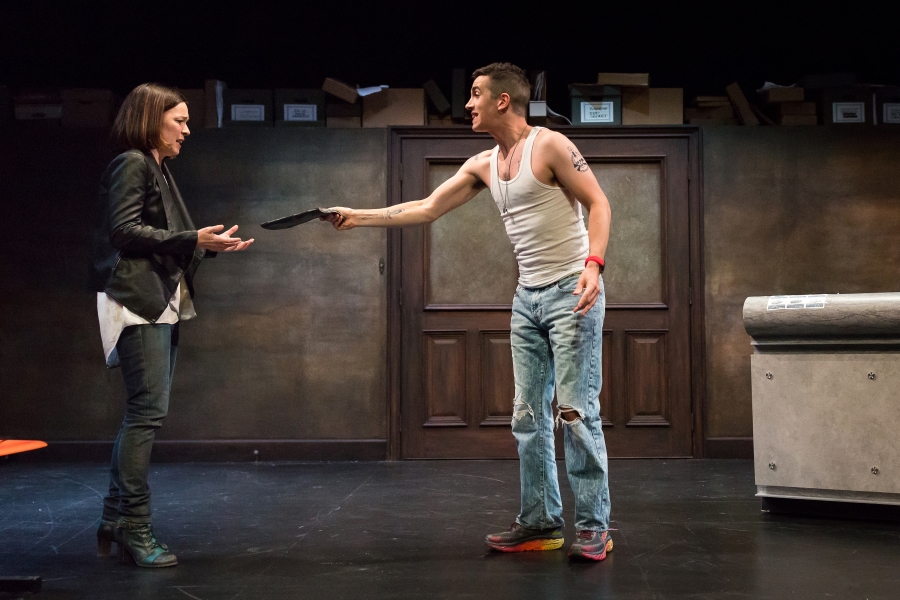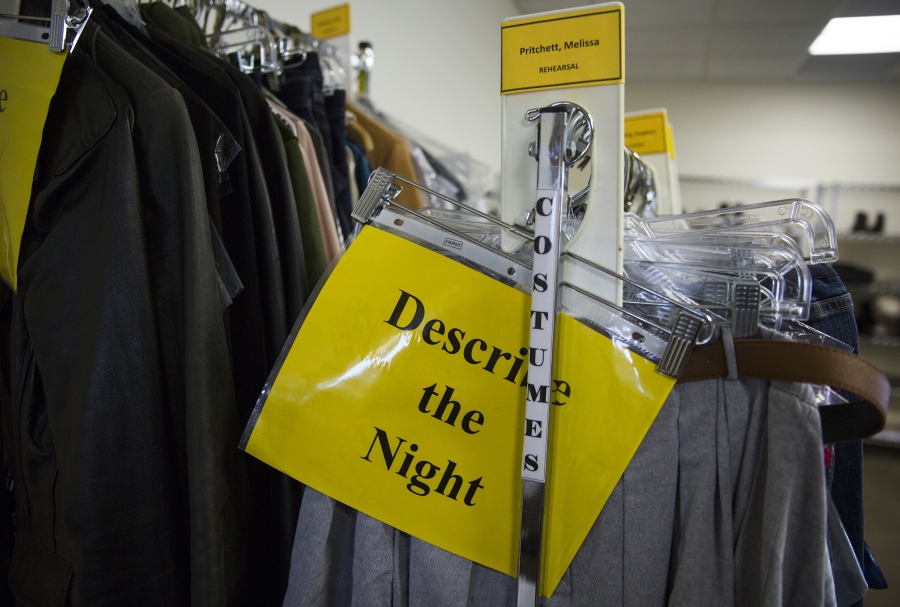On Monday, Aug. 28, the last thing playwright Rajiv Joseph imagined he’d be doing was volunteering at the George R. Brown Convention Center in downtown Houston, then a Hurricane Harvey shelter. While rains continued to flood the city, Joseph was busy writing P.A. announcements for the shelter: what time showers were arriving, when meals would be served, when lights on and off were, where there were warm dry clothes, etc.
For Joseph, the process wasn’t unlike rehearsing a new play. After getting feedback from his stage manager, Lori Lundquist, Joseph realized that he sounded like a “vice principal reading morning P.A. announcements.” But the playwright powered through his new job. “Writing is probably the only marketable skill I own in the world, and I was actually able to use in the middle of this disaster,” admits Joseph. “Once this is read out loud for 5,000 people, it will be the biggest audience I’ve ever had.”
Of course Joseph, the author of such plays as Bengal Tiger in the Baghdad Zoo and Guards at the Taj, wasn’t in town to do flood rescue work. On the other side of downtown Houston, the Alley Theatre was set to premiere his new play, Describe the Night, but the theatre was taking on floodwaters at an alarming rate. The Neuhaus Theatre—the company’s 310-seat theatre, where the show was supposed to begin performances on Sept. 15—was completely underwater. While Joseph was personally safe amid the chaos, one thing was clear: Describe the Night was in danger.
But the Alley was committed to the show going on, somehow. The theatre cancelled its annual production of The Santaland Diaries and moved the planned world premiere of Lawrence Wright’s Cleo to April 2018, plans to open Describe the Night continued along an alternate path while the theatre building recovered.
Commissioned and developed by the Alley, Describe the Night is an epic saga spanning 90 years of Russian history, interweaving the stories of seven people over three separate time periods and locations, from the tale of a Russian writer traveling with the Red Cavalry in 1920, to KGB machinations around the fall of the Berlin Wall, to the 2010 crash of a plane carrying most of the Polish government in Smolensk, Russia. In many ways, Joseph’s play is about persistence and the human bonds that we form when faced with adversity. So is the story of how Describe the Night miraculously opened on time.

First, the Alley had to find a new place to stage the play. On Monday, Aug. 28, while the storm was still pounding the city, managing director Dean Gladden reached out to two contacts at the University of Houston (UH): its president, Renu Khator, and Andrew Davis, dean of the Katherine G. McGovern College of the Arts. They struck a deal to move the show to the Quintero Theatre, a 185-seat black box on the campus. By day’s end, Describe the Night had a new home.
While most of the cast and production team were stranded in their homes, director Giovanna Sardelli, Joseph, and out-of-town actors Jason Babinsky, Liv Rooth, and Stephen Stocking were staying at the Four Seasons Hotel, and they continued rehearsals there. Even without four of the seven cast members, these sessions proved productive. While rehearsing a scene in which a KGB agent played by Babinsky seduces a woman he’s spying on, Stocking filled in as the woman so that Joseph could continue to work on the scene. Said Sardelli, “It turned out to be a fruitful rehearsal, because Rajiv was able to work on the scene,” so that by the time the actress cast in the role, Melissa Pritchett, was able to get to a rehearsal, “the scene was in the best shape it had been.”
Joseph tends to rewrite a lot during the play development process, especially when he’s working on a world premiere, with many of his tweaks coming as the team approaches the first preview. Under the circumstances, though, Joseph scaled back his tinkering. “Everyone was under so much pressure, and I didn’t want to add to that in any way,” Joseph said. “If I keep overwhelming them with rewrites then I’m not going to get the type of performance I need. Actors need time to feel comfortable in a piece. And none of us were feeling very comfortable going into tech that week. We just hadn’t had the rehearsal time.”
While Joseph and Sardelli continued working on the play, Gladden was busy handling the logistics of getting it on. By Tuesday, Aug. 29, Gladden had acquired rehearsal space in an office building downtown via a board member. When Gladden told Joseph and Sardelli that Describe the Night had secured rehearsal and performance spaces so soon, they were shocked.
But some adjustments were required: The Quintero Theatre is a thrust configuration, whereas the Neuhaus is an in-the-round configuration. “At first it seemed like an overwhelming prospect, and then it became a blessing,” Sardelli reasoned. Having to block the show for primarily one angle, Sardelli said she found a confident stillness in the show that allowed it to breathe: “It was looking at what was absolutely necessary.”

So the show had a new venue, and they had the actors. But the set, having been submerged entirely in flood waters, had to be redesigned and completely rebuilt. This forced scenic designer Tim Mackabee into set design triage. At 11 p.m. on Aug. 28, Mackabee was on the phone with Joseph and Sardelli to discuss a new approach that was as simple as it was nuanced. “To not overwhelm everyone,” Mackabee recalled, they asked each other, “What are the bare-bone essentials to this show? What are the least amount of things we can do this with?” By 8 a.m. the next morning, Mackabee had submitted drawings of a new design. And since he had no access to the Alley scene shop, anything that was needed to realize his new design had to be newly purchased and found, and in a severely shortened timeline.
The production made the most of these limitations. While the original in-the-round configuration involved several doors and corners filled with bookshelves and file boxes, Mackabee’s redesigned set added double doors as the central focal point. And Sardelli made use of them to surprise the audience. At one point, they open to reveal a furnace and the fall of the Berlin Wall. While two character take cover after the Polish airplane crash in Smolensk, explosions light up the doors’ frosted glass and shadows of police pass back-and-forth, evoking the fear of living in a police state. In other scenes, the doors serve as an elevator.
For Joseph, Mackabee’s door-centered redesign unlocked the storytelling.
“I had been struggling with the end of the first act, and there were all of these theatrical gestures we were trying to use, and I just looked at the door and it just came to us as we were sitting around late one night,” Joseph said. “Suddenly it made sense because of the door. Sometimes the design can inform a dramaturgical challenge.”

The new space had its challenges, though: While the Alley team was ready to roll even as Harvey’s rains continued to pour over Houston, UH was not. The Alley had to wait until Tuesday, Sept. 5 to begin load-in and tech at the Quintero. The condensed schedule, in tandem with having limited access to the basic necessities of mounting a show, frustrated the production team and forced them to think outside the box. Said Mackabee, “You’d ask for the simplest thing, and you could see the frustration on their face, because they had that perfect thing at the theatre in their office, which no one could get to. It made everything 10 times harder.”
As with Joseph limiting his rewrites, Sardelli had to prioritize: “Everyone working to solve the problem within the resources we had so that we didn’t create more stress. We would sometimes have a wonderful idea that could only be achieved by placing more of a burden on a department that was already taxed. Instead we asked, what is an achievable idea?”
At the new location, Gladden had his work cut out for him: He set up a new box office, managed the subscription base, and reticketed the entire run, while also working with UH to arrange parking, housekeeping, etc. Luckily, he said, “The university was great. They really bent over backwards to make everything possible.”
That’s true of the entire team that made the Describe the Night show go on.
“Exciting things happen with problems, I find, and we were handed nothing but problems,” said Mackabee. “We created something probably more exciting than what it was going to be.” Sardelli was philosophical: “I have a new perspective on what constitutes a tragedy when mounting a show.”
Now that Describe the Night is up and running in Houston, Joseph and Sardelli have turned their attention to show’s New York premiere at Atlantic Theater Company, Nov. 10-Dec. 24. Meanwhile, the Alley Theatre continues the arduous rebuilding process. Though the building still doesn’t have electricity, Gladden remains hopeful that their annual production of A Christmas Carol will go up as planned in November and that the Neuhaus will be ready for the world premiere of Lover, Beloved in February.
Marveled Alley artistic director Gregory Boyd, “What was accomplished by the artists and the theatre artisans and staff coming together to create the production in the midst of a disaster is one of the great theatre stories I know.” And he called Joseph’s play “a burningly relevant piece of theatre in this shocking Age of Trump. It would be that without the flood. In the midst of the flood, it is that and much more.”
Trevor Boffone is a Houston-based scholar, educator, and writer. He is the founder of the 50 Playwrights Project and a member of the Steering Committee for the Latinx Theatre Commons.


